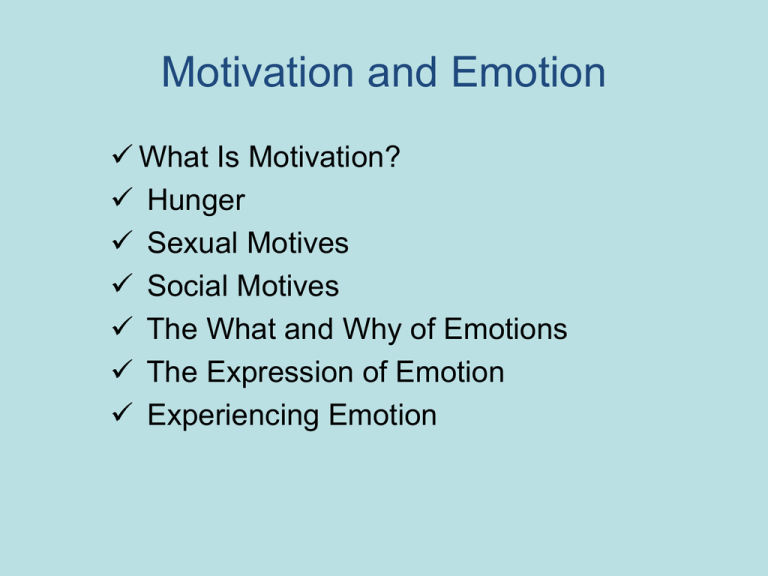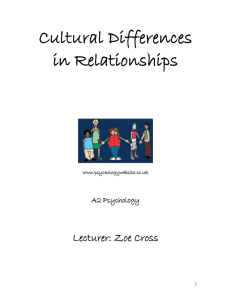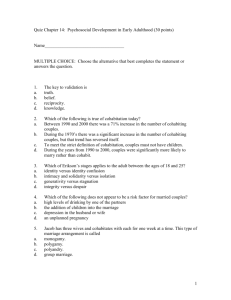Motivation
advertisement

Motivation and Emotion What Is Motivation? Hunger Sexual Motives Social Motives The What and Why of Emotions The Expression of Emotion Experiencing Emotion What is Motivation? All of the processes that initiate, direct and sustain behavior. Activation Persistence Intensity Intrinsic motivation Extrinsic motivation What are motives? Theories of Motivation Instinct theory Drive Reduction Theory Arousal Theory Yerkes-Dodson law Maslow’s Hierarchy of Needs Equilibrium is restored Satisfaction of Need Food is eaten, thirst is quenched Drive is reduced Stage of Physiological Equilibrium Drive Reduction Theory Goal-Directed Behavior Action taken to satisfy need Equilibrium is disturbed Biological Need Hunger, thirst, sleep, oxygen, elimination of waste Gives rise to drive Drive Motivates organism to engage in goal-directed behavior Internal state of arousal Yerkes-Dodson law Maslow’s Hierarchy of Needs Challenging projects, innovation and Selfactualization creativity, learning at a higher level Selfesteem Love Safety and Security Physical needs Recognition of strength, prestige, intelligence, status Acceptance, membership, love, affection Physical and economic safety and security, peace Water, food, sleep, air, clothing, exercise, sex The Hunger Drive Primary Drive Internal cues lateral hypothalamus (LH) ventromedial hypothalamus (VMH) glucose set point metabolic rate External cues Glucose, hormones, and hunger Other influences, e.g., seeing food Long time since last meal Declining levels of glucose and other nutrients in blood Other influences, e.g., stomach distension Just finished meal Increasing levels of glucose and other nutrients in blood Hunger Pancreas secrete more glucagon Satiety Pancreas secrete more glucagon Glycogen and other stored nutrients are converted to glucose, raising blood nutrient level Excess glucose and other nutrients in blood are converted to fats and other substances and stored in body cells. Surge in blood nutrients is dampened. Energy stores are developed for future needs. Eating Disorders Anorexia nervosa Bulimia nervosa Overeating Compulsive Dieting Thirst Extracellular Thirst Intracellular Thirst The Sexual Response Cycle Excitement phase Plateau phase Orgasm Sexual Orientation Heterosexual Homosexual Bisexual Asexual low heteroeroticism high low homoeroticism high 0 Sexual Orientation Exclusively heterosexual behavior Largely heterosexual, but incidental homosexual behavior 1 Largely heterosexual, but more than incidental homosexual behavior 2 Equal amounts of heterosexual and homosexual behavior 3 Largely homosexual, but more than incidental heterosexual behavior 4 Largely homosexual, but incidental heterosexual behavior 5 Exclusively homosexual behavior 6 Heterosexual Homosexual Other Motives… Social motives Competence Achievement Recognition Power Authority Components of Emotions Physical Component (feeling) Cognitive Component (thinking) Behavioral Component (doing) Theories of Emotions James-Lange theory Cannon-Bard theory Schachter-Singer theory Lazarus theory Facial-feedback hypothesis Range of emotions Facial expressions Display rules Facial feedback Gender differences Sternberg’s Theory Non-love Romantic love Infatuation Compassionate love Passion Commitment Intimacy Liking Empty love Fatuous love Consummate love





